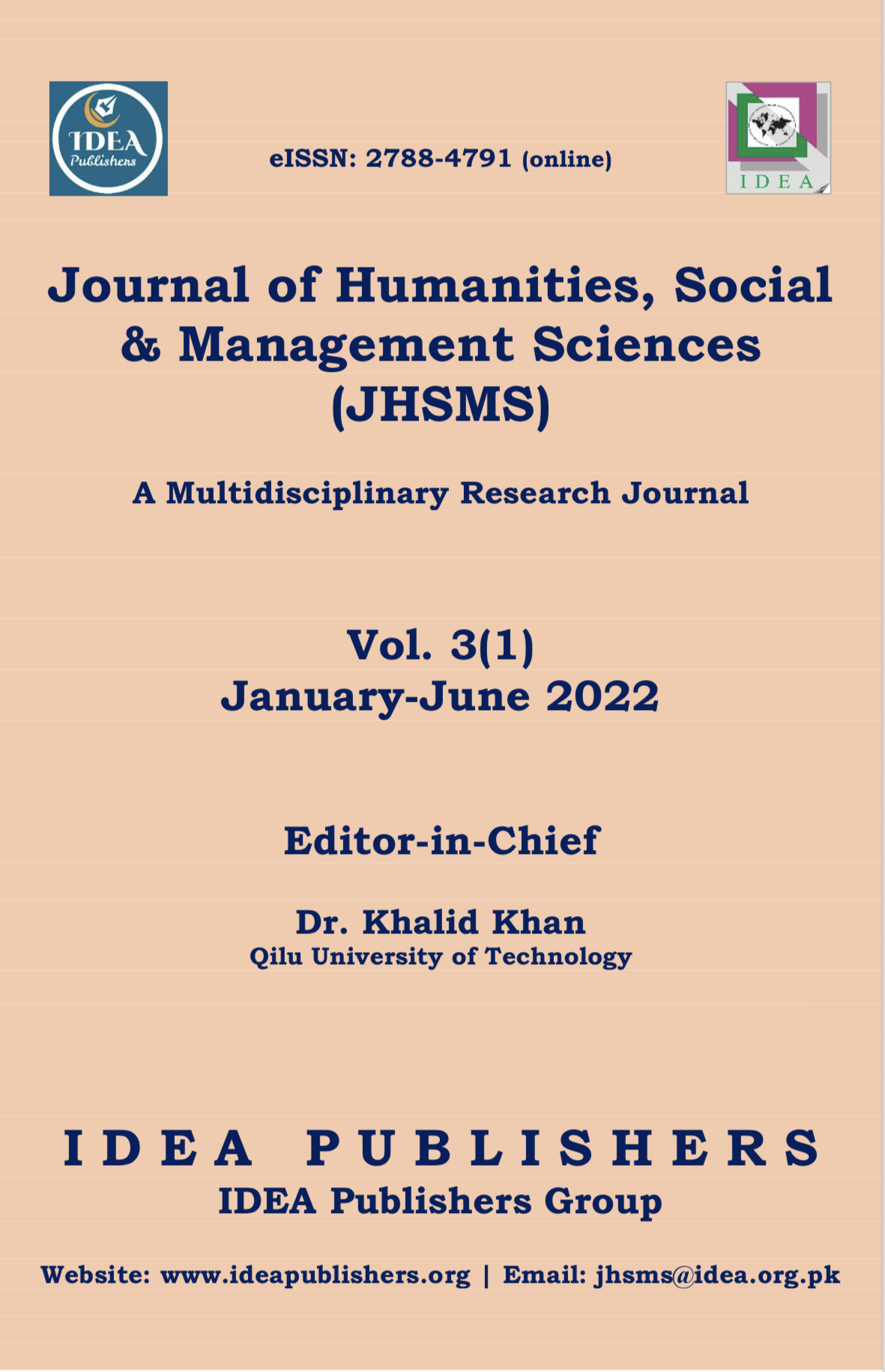Exploring gender relations in Shamsie’s Home Fire: A symbolic interaction perspective
DOI:
https://doi.org/10.47264/idea.jhsms/3.1.19Keywords:
symbolic interaction, symbolic interaction theory, gender roles, gender representation, individuality, concept of interaction, concept of interpretationAbstract
The present study examines Kamila Shamsie’s novel Home Fire (2017) for gender roles and demonstrates how gender roles determine the characters’ individuality in the text. The study has employed symbolic interaction theory to explore gender roles in the selected text. Mead (1964) and Blumer’s (1969) concepts of interaction and interpretation have been adopted to analyse gender roles. The probe into the text finds Home Fire an objective example of gender equality in terms of behaviours, professions, power, and appearance. The novel presents gender roles in natural and unique situations rather than in stereotypical ways. Shamsie has portrayed modern men and women performing distinct roles in society without engendering them. All characters behave according to their circumstances and individual personality patterns. Shamsie has maintained a terrific balance between male and female characters and has not presented women as victims or overburdened with the duties or responsibilities; nevertheless, she has presented genuine people who act differently in varying situations according to their temperaments.
References
Ahmed, R. (2021). Towards an ethics of reading Muslims: Encountering difference in Kamila Shamsie’s Home Fire. Textual Practice, 35(7), 1145-1161. https://doi.org/10.1080/0950236X.2020.1731582 DOI: https://doi.org/10.1080/0950236X.2020.1731582
Ahmed, Z., Buzdar, H. Q., & Kamran, U. (2021). Postcolonial subject as modern orient: A critical analysis of Shamsie’s Home Fire. International Journal of Linguistics and Culture, 2(2), 159-171. http://ijlc.wum.edu.pk/index.php/ojs/article/view/52 DOI: https://doi.org/10.52700/ijlc.v2i2.52
Blumer, H. (1969). Symbolic interactionism. Prentice-Hall.
Brigida, M. S., & Pinho, D. (2019). Necropolitics and national identity in Kamila Shamsie’s Home Fire. Interdisciplinar-Revista de Estudos em Língua e Literatura, 31, 153-167. https://doi.org/10.47250/intrell.v31i1.11493
Chambers, C. (2018). Sound and Fury: Kamila Shamsie's Home Fire. The Massachusetts Review, 59(2), 202-219. https://doi.org/10.1353/mar.2018.0029 DOI: https://doi.org/10.1353/mar.2018.0029
Copenhaver, B. B. (2002). The portrayal of gender and a description of gender roles in selected American modern and postmodern plays. East Tennessee State University.
Ebrahimkutty, S., & Dhantal, S. (2020). Gender role in marriage: A symbolic interactionist perspective of a Game of Thrones. Journal of Research in Humanities and Social Science, 8(10). 29-34.
Gussak, D. (2008). An interactionist perspective on understanding gender identity in art therapy. Art Therapy, 25(2), 64-69. https://doi.org/10.1080/07421656.2008.10129414 DOI: https://doi.org/10.1080/07421656.2008.10129414
Haque, S. A. A., Iqbal, H., Siddique, N., & Saeed, A. (2020). Locating cultural hegemony: A Marxist analysis of Home Fire. PalArch's Journal of Archaeology of Egypt/Egyptology, 17(9), 7925-7938. https://archives.palarch.nl/index.php/jae/article/view/5676
Lodhi, M. A., Muqqadas, S., & Sikander, S. (2019). Political Imbroglios in Kamila Shamsie’s Home Fire and Mohammad Hanif’s A Case of Exploding Mangoes. English Language and Literature Studies, 9(1), 120-133. https://pdfs.semanticscholar.org/9d7c/fa2c567d578da1df1645fdce5f9de5caff0d.pdf DOI: https://doi.org/10.5539/ells.v9n1p120
McLuhan, A. (2014). Character as a sociological phenomenon: An interactionist analysis of seminary life. Doctoral Dissertation. https://macsphere.mcmaster.ca/handle/11375/14120
Mead, G. H. (1964). On social psychology. University of Chicago.
Rivaldy, P. M. R., Budiman, M., & Tambunan, S. M. G. (2019). Muslim diasporic identities in Kamila Shamsie’s home fire (2017). International Review of Humanities Studies, 4(2), 962-972. https://doi.org/10.7454/irhs.v0i0.198 DOI: https://doi.org/10.7454/irhs.v0i0.198
Shamsie, K. (2017). Home fire. Riverhead Books.
Shaheen, A., Qamar, S., & Islam, M. (2018). Obsessive ‘Westoxification’ versus the Albatross of Fundamentalism and love as collateral damage in Kamila Shamsie’s Home Fire. Journal of Research (Humanities), 54(54), 150-167. http://pu.edu.pk/images/journal/english/PDF/09_LIV_Jan_18.pdf
Stets, J. E. & Burke, P. J. (2000). Femininity/Masculinity. In E. F. Borgatta, & R. J. V. Montgomery (Eds.), Encyclopedia of Sociology (pp. 997-1005). Macmillan. https://hmmcollege.ac.in/uploads/00b.pdf
Downloads
Published
How to Cite
Issue
Section
License
Copyright (c) 2022 Maryam Akbar, Zareena Qasim

This work is licensed under a Creative Commons Attribution-NonCommercial 4.0 International License.
Please click here for details about the Licensing and Copyright policies of IDEA-PG.















